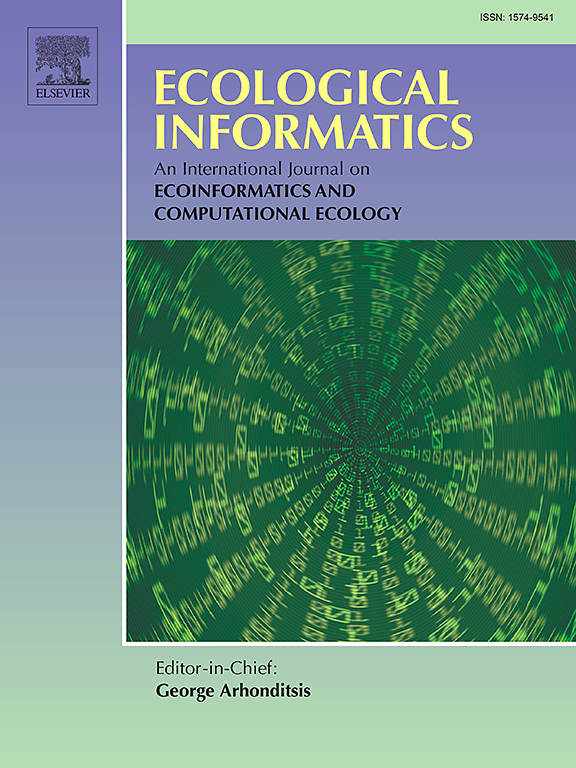DAMI-YOLOv8l: A multi-scale detection framework for light-trapping insect pest monitoring
IF 5.8
2区 环境科学与生态学
Q1 ECOLOGY
引用次数: 0
Abstract
Insect pest detection plays a crucial role in agricultural production for accurate and early pest control, thus significantly reducing crop damage and increasing yields. However, currently the small size and multi-scale characteristics of insect pests pose significant challenges for accurate object detection using computer vision technology. To address this issue, we propose a novel framework called DAMI-YOLOv8l to detect pest in images collected by a light-trapping device. The DAMI-YOLOv8l model integrates three key innovations: the Depth-wise Multi-Scale Convolution (DMC) module, the Attentional Scale Sequence Fusion with a P2 detection layer (ASF![]() P2) neck structure, and a novel bounding box regression loss function named Minimum Point Distance inner Intersection over Union (MPDinner-IoU). The DMC module improves multi-scale feature extraction to enable the effective capture and merging of features across different detection scales while reducing network parameters. The ASF-P2 neck structure enhances the fusion of multi-scale features while preserving critical local information related to small-scale features. Additionally, the MPDinner-IoU loss function optimizes feature measurement for small insect pest datasets by introducing geometric correction capabilities. By leveraging these innovations, the results demonstrate that the proposed framework improves many metrics, such as mAP50 from 74.5 % to 78.2 %, mAP50:95 from 52.5 % to 57.3 %, and FPS from 109.89 to 121.12, compared with those of YOLOv8l model on the proposed LP24 dataset. Furthermore, we validate its robustness on two other public datasets related to small objects, Pest24 and VisDrone2019.
P2) neck structure, and a novel bounding box regression loss function named Minimum Point Distance inner Intersection over Union (MPDinner-IoU). The DMC module improves multi-scale feature extraction to enable the effective capture and merging of features across different detection scales while reducing network parameters. The ASF-P2 neck structure enhances the fusion of multi-scale features while preserving critical local information related to small-scale features. Additionally, the MPDinner-IoU loss function optimizes feature measurement for small insect pest datasets by introducing geometric correction capabilities. By leveraging these innovations, the results demonstrate that the proposed framework improves many metrics, such as mAP50 from 74.5 % to 78.2 %, mAP50:95 from 52.5 % to 57.3 %, and FPS from 109.89 to 121.12, compared with those of YOLOv8l model on the proposed LP24 dataset. Furthermore, we validate its robustness on two other public datasets related to small objects, Pest24 and VisDrone2019.
DAMI-YOLOv8l:一种多尺度光捕获害虫监测框架
害虫检测在农业生产中起着至关重要的作用,可以准确、早期地防治害虫,从而大大减少作物损害,提高产量。然而,目前害虫的小尺寸和多尺度特征给计算机视觉技术的精确目标检测带来了很大的挑战。为了解决这个问题,我们提出了一个名为DAMI-YOLOv8l的新框架,用于检测由光捕获装置收集的图像中的害虫。DAMI-YOLOv8l模型集成了三个关键创新:深度多尺度卷积(DMC)模块,带有P2检测层(ASFP2)颈部结构的注意尺度序列融合,以及一种名为最小点距离内交联(mpdini - iou)的新型边界盒回归损失函数。DMC模块改进了多尺度特征提取,在减少网络参数的同时,能够有效地捕获和合并不同检测尺度的特征。ASF-P2颈部结构增强了多尺度特征的融合,同时保留了与小尺度特征相关的关键局部信息。此外,MPDinner-IoU损失函数通过引入几何校正功能,优化了小型害虫数据集的特征测量。通过利用这些创新,结果表明,与所提出的LP24数据集上的YOLOv8l模型相比,所提出的框架提高了许多指标,例如mAP50从74.5%提高到78.2%,mAP50:95从52.5%提高到57.3%,FPS从109.89提高到121.12。此外,我们在另外两个与小物体相关的公共数据集pes24和VisDrone2019上验证了其鲁棒性。
本文章由计算机程序翻译,如有差异,请以英文原文为准。
求助全文
约1分钟内获得全文
求助全文
来源期刊

Ecological Informatics
环境科学-生态学
CiteScore
8.30
自引率
11.80%
发文量
346
审稿时长
46 days
期刊介绍:
The journal Ecological Informatics is devoted to the publication of high quality, peer-reviewed articles on all aspects of computational ecology, data science and biogeography. The scope of the journal takes into account the data-intensive nature of ecology, the growing capacity of information technology to access, harness and leverage complex data as well as the critical need for informing sustainable management in view of global environmental and climate change.
The nature of the journal is interdisciplinary at the crossover between ecology and informatics. It focuses on novel concepts and techniques for image- and genome-based monitoring and interpretation, sensor- and multimedia-based data acquisition, internet-based data archiving and sharing, data assimilation, modelling and prediction of ecological data.
 求助内容:
求助内容: 应助结果提醒方式:
应助结果提醒方式:


